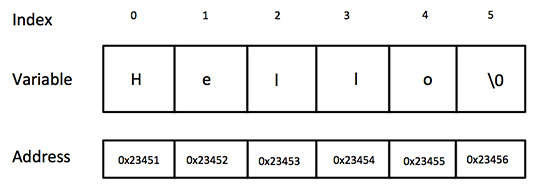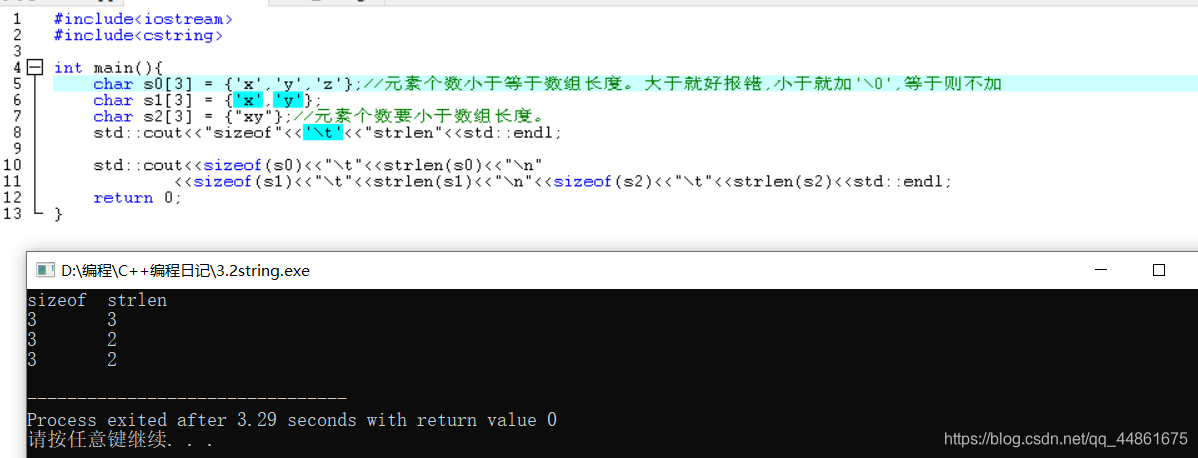C++ 大大增强了对字符串的支持,除了可以使用C风格的字符串,还可以使用内置的 string 类。string 类处理起字符串来会方便很多,完全可以代替C语言中的字符数组或字符串指针。
string 是 C++ 中常用的一个类,它非常重要,使用string类必须导入<string>.下面我们来看一下这个头文件的内部
// 21.3 Template class basic_string基础模板类
template<typename _CharT, typename _Traits, typename _Alloc>
class basic_string
{
typedef typename _Alloc::template rebind<_CharT>::other _CharT_alloc_type;
// Types:
public:
typedef _Traits traits_type;
typedef typename _Traits::char_type value_type;
typedef _Alloc allocator_type;
typedef typename _CharT_alloc_type::size_type size_type;
typedef typename _CharT_alloc_type::difference_type difference_type;
typedef typename _CharT_alloc_type::reference reference;
typedef typename _CharT_alloc_type::const_reference const_reference;
typedef typename _CharT_alloc_type::pointer pointer;
typedef typename _CharT_alloc_type::const_pointer const_pointer;
typedef __gnu_cxx::__normal_iterator<pointer, basic_string> iterator;
typedef __gnu_cxx::__normal_iterator<const_pointer, basic_string>
const_iterator;
typedef std::reverse_iterator<const_iterator> const_reverse_iterator;
typedef std::reverse_iterator<iterator> reverse_iterator;
private:
// _Rep: string representation
// Invariants:
// 1. String really contains _M_length + 1 characters: due to 21.3.4
// must be kept null-terminated.
// 2. _M_capacity >= _M_length
// Allocated memory is always (_M_capacity + 1) * sizeof(_CharT).
// 3. _M_refcount has three states:
// -1: leaked, one reference, no ref-copies allowed, non-const.
// 0: one reference, non-const.
// n>0: n + 1 references, operations require a lock, const.
// 4. All fields==0 is an empty string, given the extra storage
// beyond-the-end for a null terminator; thus, the shared
// empty string representation needs no constructor.
struct _Rep_base
{
size_type _M_length;
size_type _M_capacity;
_Atomic_word _M_refcount;
};
struct _Rep : _Rep_base
{
// Types:
typedef typename _Alloc::template rebind<char>::other _Raw_bytes_alloc;
// (Public) Data members:
// The maximum number of individual char_type elements of an
// individual string is determined by _S_max_size. This is the
// value that will be returned by max_size(). (Whereas npos
// is the maximum number of bytes the allocator can allocate.)
// If one was to divvy up the theoretical largest size string,
// with a terminating character and m _CharT elements, it'd
// look like this:
// npos = sizeof(_Rep) + (m * sizeof(_CharT)) + sizeof(_CharT)
// Solving for m:
// m = ((npos - sizeof(_Rep))/sizeof(CharT)) - 1
// In addition, this implementation quarters this amount.
static const size_type _S_max_size;
static const _CharT _S_terminal;
// The following storage is init'd to 0 by the linker, resulting
// (carefully) in an empty string with one reference.
static size_type _S_empty_rep_storage[];
static _Rep&
_S_empty_rep()
{
// NB: Mild hack to avoid strict-aliasing warnings. Note that
// _S_empty_rep_storage is never modified and the punning should
// be reasonably safe in this case.
void* __p = reinterpret_cast<void*>(&_S_empty_rep_storage);
return *reinterpret_cast<_Rep*>(__p);
}
bool
_M_is_leaked() const
{ return this->_M_refcount < 0; }
在cstring或者string.h头文件中
字符在内存中的样子

例子演示
定义了数组长度,在内存里面的长度,使用strlen计算的长度

不定义数组长度,在内存里面的长度,使用strlen计算的长度

例子2
char str[ ];
str="I am happy";//错误,字符数组的赋值只能按元素一一赋值
//char str[ ]={"I am happy"};
| 序号 | 函数 | 目的 |
|---|---|---|
| 1 | strcpy(s1, s2); | 复制字符串 s2 到字符串 s1。 |
| 2 | strcat(s1, s2); | 连接字符串 s2 到字符串 s1 的末尾。 |
| 3 | strlen(s1); | 返回字符串 s1 的长度。不计‘\0’ |
| 4 | strcmp(s1, s2); | 如果 s1 和 s2 是相同的,则返回 0;如果 s1<s2 则返回值小于 0;如果 s1>s2 则返回值大于 0。 |
| 5 | strchr(s1, ch); | 返回一个指针,指向字符串 s1 中字符 ch 的第一次出现的位置。 |
| 6 | strstr(s1, s2); | 返回一个指针,指向字符串 s1 中字符串 s2 的第一次出现的位置。 |
string头文件中
例子1
#include <iostream>
#include <string>
using namespace std;
int main(){
string s1;
string s2 = "c plus plus";
string s3 = s2;
string s4 (5, 's');
return 0;
}
变量 s1 只是定义但没有初始化,编译器会将默认值赋给 s1,默认值是"",也即空字符串。
变量 s2 在定义的同时被初始化为"c plus plus"。与C风格的字符串不同,string 的结尾没有结束标志'\0'。
变量 s3 在定义的时候直接用 s2 进行初始化,因此 s3 的内容也是"c plus plus"。
变量 s4 被初始化为由 5 个’s’字符组成的字符串,也就是"sssss"。
从上面的代码可以看出,string 变量可以直接通过赋值操作符=进行赋值。string 变量也可以用C风格的字符串进行赋值,例如,s2 是用一个字符串常量进行初始化的,而 s3 则是通过 s2 变量进行初始化的。
转化为c风格字符串,为了使用c提供的文件指针
然 C++ 提供了 string 类来替代C语言中的字符串,但是在实际编程中,有时候必须要使用C风格的字符串(例如打开文件时的路径),为此,string 类为我们提供了一个转换函数 c_str(),该函数能够将 string 字符串转换为C风格的字符串,并返回该字符串的 const 指针(const char*)
string path = "D:\\demo.txt";
FILE *fp = fopen(path.c_str(), "rt");
string类特性
- 运算符重载
- +和 +=:连接字符串
- =:字符串赋值
- < 、 <=、>=:字符串比较(例如a < b, aa < ab)
- ==、!=:比较字符串
- <<、>>:输出、输入字符串
注意:使用重载的运算符 + 时,必须保证前两个操作数至少有一个为 string 类型。
相关函数总结
| 序号 | 函数 | 作用 |
|---|---|---|
| 1 | insert() 函数 | string& insert (size_t pos, const string& str);pos 表示要插入的位置,也就是下标;str 表示要插入的字符串 |
| 2 | erase() 函数 | string& erase (size_t pos = 0, size_t len = npos);pos 表示要删除的子字符串的起始下标,len 表示要删除子字符串的长度。如果不指明 len 的话,那么直接删除从 pos 到字符串结束处的所有字符 |
| 3 | substr() 函数 | string substr (size_t pos = 0, size_t len = npos) const;pos 为要提取的子字符串的起始下标,len 为要提取的子字符串的长度。 |
| 4 | find() 函数 | size_t find (const string& str, size_t pos = 0) const; size_t find (const char* s, size_t pos = 0) const;两种原型 |
| 5 | rfind() 函数 | rfind() 和 find() 很类似,同样是在字符串中查找子字符串,不同的是 find() 函数从第二个参数开始往后查找,而 rfind() 函数则最多查找到第二个参数处,如果到了第二个参数所指定的下标还没有找到子字符串,则返回一个无穷大值4294967295。 |
| 6 | find_first_of() 函数 | find_first_of() 函数用于查找子字符串和字符串共同具有的字符在字符串中首次出现的位置。 |
| 7 | swap()函数 | str1.swap(str2);//把 str1 与 str2 交换 |
